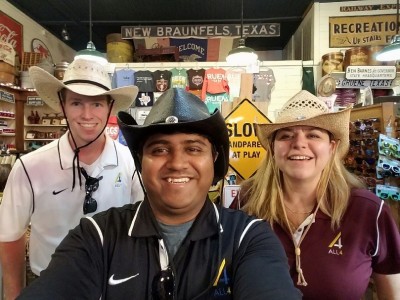A Reflection on TCEQ’s Advanced Air Permitting Seminar in Austin, TX
Posted: November 8th, 2016
Authors: Frank D.
On a relatively cool (in-terms of Houston’s standards) Monday October morning, Abhishek, Kristin, and I ventured to our state’s capital to attend the much anticipated Texas Commission on Environmental Quality (TCEQ) Advanced Air Permitting Seminar (Seminar). After a much needed pit stop at an Austin-staple restaurant, known as Threadgill’s, where we indulged in some good ole’ fashioned home cooking with our fair share of cornbread and hush puppies, we were ready to tackle our favorite TCEQ event of the year. At the Seminar, not only did TCEQ discuss the usual air quality related topics, such as Best Available Control Technology (BACT), Lowest Achievable Emission Rate (LAER), Federal New Source Review (NSR), Nonattainment NSR, and compliance and enforcement matters, but TCEQ also discussed programs and solutions to Texas-specific permitting. TCEQ emphasized its commitment to increasing the efficiency of its permitting programs, and discussed the appropriate uses of Permit by Rules (PBRs). TCEQ also introduced one of its newest permitting additions: Readily Available Permits (RAPs). Let’s take quick a dive into just some of the topics discussed at the Seminar.
BACT/LAER
Fun fact: Did you know that Air Permits celebrate their 45th anniversary this year? Can you remember where you were 45 years ago? Well I digress, fast forward 45 years to the Seminar and two takeaways from BACT/LAER session are listed below:
- The U.S. Environmental Protection Agency (U.S. EPA) requires a “top-down method” to evaluate BACT while TCEQ uses a three-tiered approach to evaluate BACT. Yes, the approaches reach the same conclusion, just be sure you articulate to TCEQ what approach you will use in your analysis, to avoid any confusion and possible delays in your permit review.
- When evaluating the collateral impacts of a technically feasible control technology, TCEQ requires a detailed cost analysis for anticipated annualized capital and operating costs. Be sure to include actual vendor quotes that provide anticipated annualized capital and operating costs associated with the control technology. Remember, it may take some time to obtain vendor quotes, so be sure to budget your time and project schedule accordingly.
Investigations and Enforcement
Did you know that TCEQ Regional offices conduct announced and unannounced investigations? For other tidbits that TCEQ shared during their investigations and enforcement discussions, check out the bullets below:
- One of the most common facility violations according to TCEQ is the failure to submit annual and semiannual reports (i.e., permit compliance certifications and semi-annual deviations reports). Be sure you have someone at your facility tagged to complete these reports before their due dates to avoid TCEQ violations.
- Other common facility violations include the failure of stack tests, unauthorized emissions events and having unpermitted sources. Keep in mind that eventually these violations make their way for public viewing on U.S. EPA’s Enforcement and Compliance History Online (ECHO) dashboard. Remember to be proactive rather than reactive when it comes to potential violations and how you can be in action now to prevent them.
PBRs
PBRs have been used by TCEQ to increase permit review efficiency. While the intent of PBRs are to decrease the time and complexity associated with issuing permits, common misconceptions or misunderstandings can delay PBRs from being issued. Below are some fast facts about PBRs discussed at the Seminar:
- Communication between the PBR reviewer and a technical contact at your facility is encouraged to answer common questions TCEQ may have regarding the project. Having open communication with TCEQ will only increase the permitting efficiency of your proposed project. Some common questions TCEQ may ask while reviewing a PBR include:
- Will the project impact upstream/downstream emissions sources thereby triggering emissions increases from these emissions sources? If upstream and downstream emissions sources are affected by the project, TCEQ can likely conclude that the scope of your project is larger than what you have presented.
- Are the increases in emissions controlled or uncontrolled?
- Are there any special conditions being proposed?
- Remember, when applying for a PBR, TCEQ looks at the increase above the actual emissions from the project rather than the increase above the allowable emissions (i.e., permitted limits). Don’t get caught delaying your PBR because the increase in actual emissions was not presented.
Oil and Gas Hot Topics
A subject that was on everyone’s minds at the Seminar was oil and gas related. Below are two of several important takeaways from the Seminar about oil and gas topics:
- For tanks potentially subject to Standards of Performance for New Stationary Sources (NSPS) Subpart OOOO that have potential uncontrolled emissions less than 6 tons per year (tpy), facilities can use the APD-CERT via the State of Texas Environmental Electronic Reporting System (STEERS) to document that the tank emissions are below the volatile organic compounds (VOC) emissions threshold of 6 tpy. In a review of the applicability of 40 CFR §60.5365, these tanks would not be subject to NSPS OOOO. Be sure that you know how to navigate STEERS to access this compliance option.
- For new oil and gas handling and production projects located in the Barnet Shale area, in accordance with 30 TAC 106.352(f), the facility must register the project through STEERS. Keep in mind that TCEQ is continuing their trend of increasing the amount of permitting through online media (i.e., ePermits).
RAPs
TCEQ has an overall goal of reducing the processing time required for its staff to issue initial permits and amendments. Stay tuned for more on this permitting option in ALL4’s next Texas-specific blog. For now, below are the main takeaways from the RAPs session:
- The purpose of RAPs is to streamline TCEQ’s permitting process by making the current case-by-case permitting process more efficient.
- RAPs require an applicant to file all technical information up-front in an effort to eliminate back-and-forth requests for additional information.
- TCEQ will issue a rigid permit with pre-approved permit conditions if all technical information is provided thereby significantly reducing the time needed to write a site-specific permit.
To cap off our two eventful 
This is the initial blog of a few Texas specific blogs being developed by ALL4 over the next couple of weeks. Be on the lookout for blogs providing more detailed information on RAPs and Emissions Inventories. In the meantime, feel free to reach out and give ALL4 a call and we’d be more than happy to discuss our roles from a Texas air quality consulting perspective, and how we can help make your lives easier when it comes to your facility’s compliance. Kristin Gordon (kgordon@all4inc.com, 281-937-7553 x301) Abhishek Bhat (abhat@all4inc.com, 281-937-7553 x304), or I (fdougherty@all4inc.com, 281-933-5246 x302) would be happy to help!

